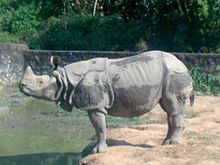History
The 64th session of Indian National Congress was held in Guwahati, in 1957. The Organising committee of INC organised an exhibit with included few animals and birds, of which a female leopard cub named Spotty was the favourite. After the meeting came to an end, it was felt to necessity of a zoo to house these animals.
These animals were shifted to Japorigog in the Hengrabari Reserve forest, with an area of 130 Hectare, suitable to create facilities and house these animals, thus, The Assam State Zoo was established in the year 1957 and was open to public viewing in the year 1958.
Over the years, the zoo grew and expanded to accommodate eye-catching exotic ones like Orangutans, black panther & Indian rhinoceros, zebras, ostriches and giraffes , etc. To get these exotic animals the zoo used to send indigenous animals like one horned Indian rhinoceros and others, to many countries. Through later the importance was shifted to indigenous species and several captive breeding programs also started which were successful. In the year 1959 a forest division was created as Assam State Zoo Division and the zoo was put under this division.
The Assam State Zoo also added a museum and in the year 1982 a botanical garden and so Assam State Zoo became The Assam State Zoo cum Botanical Garden.
In 2002 another 45 hectare area of the Hengrabari Reserve Forests were added to the zoo and thus, the total area of the zoo became 175 hectare and in August, 2005 the Animal Adoption Scheme launched.

Kaziranga National Park is a national park in the Golaghat and Nagaon districts of the state of Assam, India. The park, which hosts two-thirds of the world's Indian rhinoceroses, is a UNESCO World Heritage Site. According to the census held in March 2018 which was jointly conducted by the Forest Department of the Government of Assam and some recognized wildlife NGOs, the rhino population in Kaziranga National Park is 2,613. It comprises 1,641 adult rhinos ; 387 sub-adults ; and 385 calves.
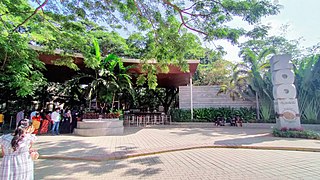
Mysore Zoo, officially known as Sri Chamarajendra Zoological Gardens, is a composite of zoological gardens and animal park located in the southern Indian city of Mysore, Karnataka. Stretching across a 157-acre (64 ha)-expanse and situated at about 700 metres from Mysore Palace, it is the oldest zoo in India and one of the oldest in the world. One of the most popular zoos in India and one of the city's most popular attractions, it is home to a wide range of over 168 species.
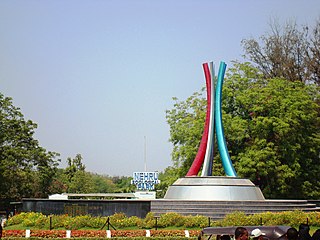
Nehru Zoological Park is a zoo located near Mir Alam Tank in Bahadurpura, Telangana, India. It is one of the most visited destinations in Hyderabad.
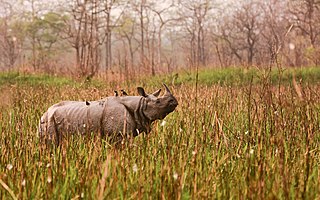
Orang National Park is a national park in India located on the northern bank of the Brahmaputra River in the Darrang and Sonitpur districts of Assam. It covers an area of 79.28 km2 (30.61 sq mi). It was established as a sanctuary in 1985 and declared a national park on 13 April 1999. It is rich in flora and fauna, including great Indian rhinoceros, pygmy hog, Asian elephant, wild water buffalo and the Bengal tiger. It is the only stronghold of the rhinoceros on the north bank of the Brahmaputra.

Dhubri is a town and the administrative centre of Dhubri district in the Indian state of Assam. It is an old town on the bank of the Brahmaputra river, with historical significance. In 1883, the town was first constituted as a Municipal Board under the British regime. It is situated about 277.4 kilometres (172 mi) west from Dispur, the state capital of Assam.
Hengrabari is located in the capital city of Guwahati of Assam, a state on the north-east of India. Densely populated, Hengrabari resembles the character of a small town in the heart of Guwahati. A few decades ago the areas around Hengrabari were covered with dense forest, tall trees and wild bushes. However, with the pressure of increase in population, these forests were burned and cleared, the hillocks were cut down and the plain agricultural land were filled up for building houses and commercial shops.

Nandankanan Zoological Park is a 437-hectare (1,080-acre) zoo and botanical garden in Bhubaneswar, Odisha, India. Established in 1960, it was opened to the public in 1979 and became the first zoo in India to join World Association of Zoos and Aquariums (WAZA) in 2009. It also contains a botanical garden and part of it has been declared a sanctuary. Nandankanan, literally meaning The Garden of Heaven, is located near the capital city, Bhubaneswar, in the environs of the Chandaka forest, and includes the 134-acre (54 ha) Kanjia lake.
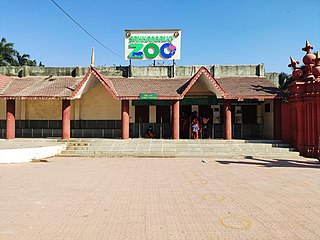
Sakkarbaug Zoological Garden also known as Sakkarbaug Zoo or Junagadh Zoo is an 84-hectare (210-acre) zoo that opened in 1863 at Junagadh, Gujarat, India. The zoo provides purebred Asiatic lions for the Indian and the international endangered species captive breeding program for the critically endangered species. Wild free ranging Asiatic lions have become extinct over most of Asia and are today found only in the nearby Gir Forest.

Kaziranga National Park is an Indian national park and an UNESCO World Heritage Site situated in the Golaghat and Nagaon district of Assam, India. It is a tourist destination and conservation area particularly notable as a refuge for the endangered Indian one-horned rhinoceros, hosting the largest population of wild Indian one-horned Rhinoceros in the world. The park contains significant stock of three other large herbivores — the Asian Elephant, the Asiatic Water Buffalo and the eastern subspecies of the Swamp Deer. Kaziranga also has the highest density of tiger in the world and is declared a Tiger Reserve in 2006. Kaziranga is recognized as an Important Bird Area by Birdlife International for conservation of avifaunal species.

Indira Gandhi Zoological Park is located amidst Kambalakonda Reserve Forest in Visakhapatnam, Andhra Pradesh, India. It is the third largest zoo in the country.

The Thiruvananthapuram Zoo is located in the city of Thiruvananthapuram, the capital of Kerala, India. It occupies 55 acres (22 ha) of woodland, lakes, and lawns.

Chhatbir Zoo, is a zoological park situated close to Zirakpur, India. The zoo was constructed in the 1970s and is home to a large variety of birds, mammals and reptiles.

Sanjay Gandhi Jaivik Udyan or Patna Zoo is located off Bailey Road in Patna, Bihar, India. The park was opened to the public as a zoo in 1973. The park is Patna's most frequented picnic spot, with more than 36,000 visitors on New Year's Day alone in 2022.

The National Zoological Park is a 176-acre (71 ha) zoo in New Delhi, India.
Nawab Wajid Ali Shah Prani Udyan, earlier known as Prince of Wales Zoological Gardens or popularly known as Lucknow Zoological Garden, and Banaarsi Baag, is a 71.6-acre (29.0 ha) zoo located in the heart of the capital city of Uttar Pradesh named after Wajid Ali Shah - the last Nawab of Awadh. According to the Central Zoo Authority of India, it is a large zoo. The Prince of Wales Zoological Gardens, was established in the year 1921 to commemorate the visit of the Prince of Wales to Lucknow. The idea of establishing Zoological gardens at Lucknow emanated from Sir Harcourt Butler, the Governor of the State.
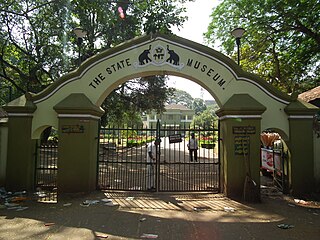
Thrissur Zoo or State Museum & Zoo, Thrissur is a 13.5-acre (5.5 ha) zoo that opened in 1885 in a small area called Chembukkavu, in the heart of Thrissur City, Kerala, India. It is one of the oldest zoos in the country and is home to a wide variety of animals, reptiles, and birds. The zoo compound includes a natural history museum and an art museum that showcase the social and cultural heritage of the region. The Thrissur Zoo is 2 kilometres (1.2 mi) from the Thrissur City center and is open from 10:00 AM till 5:15 PM, except on Mondays. Being one of the two Zoological Parks in the state of Kerala, it sees many visitors on a regularly. Still and video cameras are allowed in the park for a small fee.
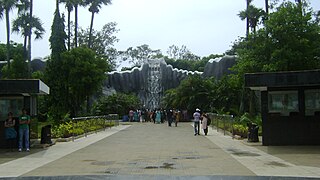
Arignar Anna Zoological Park, also known as the Vandalur Zoo, is a zoological garden located in Vandalur, to southwest of Chennai, Tamil Nadu, about 31 kilometres (19 mi) from the Chennai Central and 15 kilometres (9.3 mi) from Chennai Airport. Established in 1855, it is the first public zoo in India. It is affiliated with the Central Zoo Authority of India. Spread over an area of 602 hectares, including a 92.45-hectare (228.4-acre) rescue and rehabilitation centre, the park is the largest zoological park in India. The zoo houses 2,553 species of flora and fauna across 1,265 acres (512 ha). As of 2012 the park houses around 1,500 wild species, including 46 endangered species, in its 160 enclosures. As of 2010, there were about 47 species of mammals, 63 species of birds, 31 species of reptiles, 5 species of amphibians, 28 species of fishes, and 10 species of insects in the park. The park, with an objective to be a repository of the state's fauna, is credited with being the second wildlife sanctuary in Tamil Nadu after Mudumalai National Park.

Northeast India consists of the eight states Arunachal Pradesh, Assam, Manipur, Meghalaya, Mizoram, Nagaland, Sikkim and Tripura. Tourism in this area is based around the unique Himalayan landscape and culture distinct from the rest of India.
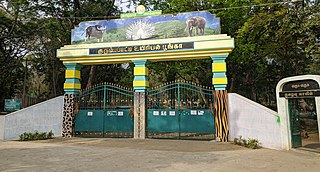
The Kurumbapatti Zoological Park is a second largest zoo in Tamil Nadu next to Arignar Anna Zoological Park, situated in the foothills of the Shervaroyan Hills, 10 km from Salem, Tamil Nadu, India. It was set up in 1981 as a small museum and was later extended to 69 Ha. The zoo houses many species of wildlife, with monkeys as the major attraction, and is in the vicinity of reserve forest, permitting visitors the opportunity to also experience the flora and fauna there. The park has a gentle topography, areas of bamboo and woodland and semi-perennial streams. Facilities include a children's playground area.

The Department of Biodiversity, Conservation and Attractions (DBCA) is the Western Australian government department responsible for managing lands and waters described in the Conservation and Land Management Act 1984, the Rottnest Island Authority Act 1987, the Swan and Canning Rivers Management Act 2006, the Botanic Gardens and Parks Authority Act 1998, and the Zoological Parks Authority Act 2001, and implementing the state's conservation and environment legislation and regulations. The Department reports to the Minister for Environment and the Minister for Tourism.

